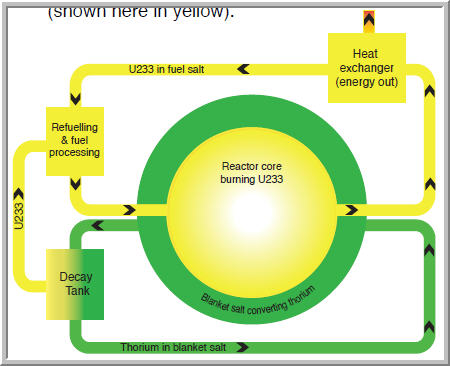By Walter Sorochan Emeritus Professor San Diego State University
Posted April 20, 2012; Updated November 13, 2021. Disclaimer The information displayed herein is intended to simplify the complexity of the nuclear power plants.
The nuclear power plant disasters at Three Mile Island, Chernobyl and Fukushima have made all of us aware of the dangers inherent in using uranium to generate electricity. Overlooked in the heat of these catastrophes has been thorium, a safer alternative to uranium. The mass media has given no attention to thorium. But this may be changing as countries the world over are attempting to harness thorium as a safer substitute energy for uranium. Countries like India and China, where air pollution has become a crisis death, are endeavoring to implement thorium power plants to generate clearner electricity.
Purpose of article: Awareness that there is a safer alternative fuel to current nuclear power plants.
Kirk Sorensen discuses in U-tube: Thorium as an alternative power supply to nuclear radiation: 10 mns long
Switching from uranium to thorium as our primarily energy fuel could lead to cheaper, safer and more sustainable nuclear power. If you haven't heard of thorium or this idea, you are not alone! This article looks into this well kept secret. So .... what is thorium?
Thorium: "is a natural radioactive chemical element with the symbol Th
and atomic number 90. It was discovered in 1828 and named after Thor, the Norse god of thunder. In nature, virtually all thorium is found as thorium-232, and it decays by emitting an alpha particle, and has a half-life of about 14.05 billion years (other, trace-level isotopes of thorium are short-lived intermediates of decay chains). It is estimated to be about four times more abundant than uranium in the Earth's crust and is a by-product of the extraction of rare
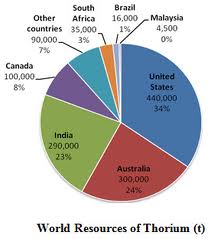 earths from monazite sands. Thorium was formerly used commonly as the light source in gas mantles and as an alloying material, but these applications have declined due to concerns about its radioactivity." Wiki: Thorium
earths from monazite sands. Thorium was formerly used commonly as the light source in gas mantles and as an alloying material, but these applications have declined due to concerns about its radioactivity." Wiki: Thorium
Monazite, the most common and commercially most important thorium-bearing mineral, is widely distributed in nature. Monazite is chiefly obtained as a sand, which is separated from other sands by physical or mechanical means. Robert Hargraves and Ralph Moir explore the early days of decisions about selecting a nuclear power plant technology --- uranium vs thorium. Enrico Fermi argued that the uranium-plutonium breeder made more weapons faster in the Manhattan Project. Atomic physicist Edward Teller promoted the LFTR to the last month of his life. Thorium LFTR: LFTR = Liquid Fluoride Reactor Reduce
Advantage of thorium vs. uranium & coal:
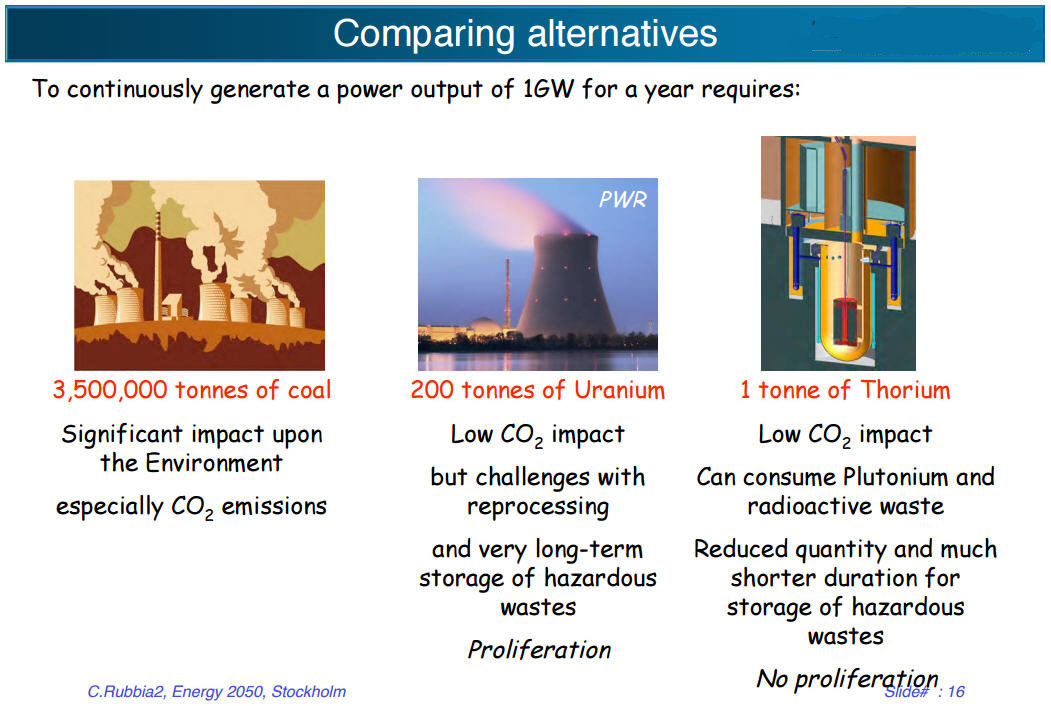
|
History of Thorium as energy source: The origin historical report of Hargraves Robert and Ralph Moir, "Liquid Fluoride Thorium Reactors," has been taken off the internet. However, the historical aspects have been saved in this section. All is not lost as you can view the history on World Nuclear Assoc: history The idea of a liquid-fuel nuclear reactor is not new. Enrico Fermi, creator in 1942 of the first nuclear reactor in a pile of graphite and uranium blocks at the University of Chicago, started up the world’s first liquid-fuel reactor two years later in 1944, using uranium sulfate fuel dissolved in water. At the very beginning of nuclear power, thorium and uranium had long been known as potential sources of nuclear fuel to produce electricity. Having two choices of fuel and numerous types of reactors was a difficult choice for scientists in those days. Most of the early research on nuclear power was done in Germany, USSR, France, United Kingdom, Canada and United States. After the war, research continued mainly in United States and USSR. Scientists working on the Manhatten project in 1942 to build an atomic bomb had to choose which reactor possibilities to pursue, which to ignore. A team of scientists led by Robert Oppenheimer built and tested the first nuclear bomb at Los Alamos, New Mexico, USA. After the atomic bomb was made and dropped on Japan, scientists turned to harnessing a nuclear reactor for peaceful electric energy purposes. Two military developments with important implications for power generation were the nuclear submarine and the nuclear-power aircraft carrier. Both of these used the Pressure Water Reactor or PWR, which was to become the most widely used reactor type in civil nuclear power. Chater: history nuclear power The first nuclear reactor to produce a small amount of electricity was the small Experimental Breeder reactor (EBR-1) in Idaho, in the USA, which started up in December 1951. In 1953 President Eisenhower proposed his "Atoms for Peace" program, which reoriented significant research effort toward electricity generation and set the course for civil nuclear energy development in the USA World Nuclear Assoc: history Among the many choices made, perhaps the most important choice for the future trajectory of nuclear power was decided by Admiral Hyman Rickover, the strong-willed Director of Naval Reactors. He decided that the first nuclear submarine, the USS Nautilus, would be powered by solid uranium oxide enriched in uranium-235, using water as coolant and moderator. The Nautilus took to sea successfully in 1955. Building on the momentum of research and spending for the Nautilus reactor, a reactor of similar design was installed at the Shippingport Atomic Power. This relatively small reactor ran on thorium from 1977 until decommissioned in 1982. In 1952, in response to a radical scheme to develop a reactor-powered aircraft, a revolutionary reactor was built using a liquid fuel. This led to the Molten Salt Reactor(MSR), which was designed and built and operated for five years. Capable of burning any nuclear fuel, the MSR forms the fissile energy producing part of the LFTR [ shown in the diagram below in yellow ]. Fissile means it cannot go "critical" and generate a nuclear chain reaction.
In June 1965 until 1969, the boys at Oak Ridge National Laboratory [ORNL] in Tennessee played with an experimental Molten-Salt Reactor Experiment (MSRE), that was designed to operate on the thorium fuel cycle. In place of the familiar fuel rods of modern nuclear plants, the MSRE used liquid fuel—hot fluoride salt containing dissolved fissile material in a solution roughly the viscosity of water at operating temperature. Fissile means it cannot go "critical" and generate a nuclear chain reaction. The MSRE ran successfully for five years, opening a new window on nuclear technology. In what has been called a political move, the US Atomic Energy Commission, during President Nixon's watch, shut down all research on liquid-fluoride reactors in 1976s. The commercial-scale Fort St. Vrain reactor ran on thorium and high-enriched uranium fuel from 1976-1989. Current domestic thorium-based reactor research is being carried out by US-based Lightbridge Corp., formerly Thorium Power. Lightbridge is collaborating with French and Russian private and government interests to develop commercial thorium-fueled reactors. Canada has signed agreements with three Chinese entities to demonstrate and develop the use of thorium fuel in their CanDU [ Canada Deuterium-Uranium ] reactors. Thorium can be used in most advanced nuclear fuel cycle systems including the newest Generation IV reactors. Because of its abundant resources of thorium and domestic lack of uranium, India has been the only country until 2010 with a sustained effort to use thorium in large scale nuclear power generation. India's 20-year goal is to generate 75% of nuclear power from thorium. Used fuel will be reprocessed to recover fissile material for recycling. The outlook for harnessing thorium instead of uranium as a source of power as a plan leaped in 2010. But in a political movement in 2018, India slashed its plan for more thorium power plants by 66% in 2018. India cuts back on power 2018 |
Dr. Robert Hargraves, Why thorium is cheaper, safer than coal; Length= 39:14 mns.
Source: Hargraves: Thorium cheaper than coal 2015
Differences between thorium and uranium:
Thorium is much different than uranium when used as a nuclear fuel. It is not fissile; meaning it cannot go critical and generate a nuclear chain reaction. This is referred to as thorium's safety valve by Sorensen. It must undergo neutron bombardment to produce a radionuclide that can sustain a nuclear reaction. A thorium-fueled reactor must be jump-started with a fissile isotope such as uranium (U235) and/or plutonium (Pu239; Pu241). Neutron bombardment of thorium results in this reaction: Th232 + Neutron = U233.
Uranium233 is a man-made fissile isotope with a half-life of 160,000 years, and is well-suited for use in nuclear reactors. After Th232 is converted, U233 can be unloaded and then fed to the core of another reactor to be used as fuel in a closed cycle.
Alternatively, U233 can be bred from thorium in an outer blanket surrounding a plutonium and/or uranium core, the U233 separated, and then fed back into the core. These are called "breeder reactors" because thorium is the fertile fuel that breeds a fissile radionuclide. Radioactive materials are recycled so there is little waste left behind.
There are other significant advantages to the use of thorium in nuclear reactors. The raw material, thorium, is much more abundant than uranium and emits only low-level alpha particles. It has one isotope and therefore, does not require an enrichment cycle to be used as fuel. It is many times more energy efficient than uranium.
A thorium reactor produces no plutonium that can be made into atomic weapons and less longer-lived radionuclides than a uranium-based reactor. Because there is no chain reaction, there is no chance of a meltdown. Fissile means it cannot go "critical" and generate a nuclear chain reaction. Nuclear waste from past operations that contain fissile uranium and plutonium can be used as start-up fuel.
Conclusions about thorium as a substitue for uranium:
Thorium is a natural, abundant energy source of extraordinary energy density.
The technology to unlock the potential of thorium is real and proven—it needs to be engineered into a commercial product.
If done properly, small modular thorium reactors can be built that can be “drop-in” replacements for coal plants, minimizing the cost of transition.
Thorium energy can also be used to replace etroleum fuels [ replace gasoline and diesel ], desalinate seawater, and provide heating. TEA: thorium info 2012 Thorium LFTR: LFTR = Liquid Fluoride Reactor Reduce
This LFTR reactor engine is made up of the following components:
Liquid: The fuel in this reactor is a molten salt. The reason for a liquid fuel form is that the fuel can be continuously circulated through the reactor vessel, allowing complete burnup and continuous processing of the fuel with continuous addition of new fuel.
Fluoride: The salts used are Fluoride salts. mThese Fluoride salts are stable at high temperatures and high radioactivity and can stay in use beyond the life of the reactor. A molten salt reactor could 'crack' water to produce fuel for Hydrogen powered vehicles. Waste heat could be used to desalinate sea water.
Thorium: Thorium is a fertile fuel, meaning that it must first be converted into a fissile form before it can produce power. Virtually all the naturally occurring Thorium is able to be used as reactor fuel, as opposed to the 2% of Uranium which is useful as fuel. One ton of Thorium can generate one gigawatt of electricity for a year.
Reactor: This device is a nuclear reactor, but not like any reactor you've ever heard of before. This is a non-volatile system, extremely resistant to proliferation and producing a small amount of short lived, low toxicity waste which is completely benign within 350 years; that is thorium has a half-life of 350 years. It costs less to build, because it doesn't operate at high pressure and it costs less to run because Thorium is a relatively cheap, plentiful fuel.
LFTR power can provide carbon free energy security cheaper than coal for thousands of years. TEA: thorium info 2012
Molten Salt Reactor: In 1952, in response to a radical scheme to develop a reactor-powered aircraft, a revolutionary reactor was built using a liquid fuel. This led to the Molten Salt Reactor(MSR), which was designed, built and operated for five years. Capable of burning any nuclear fuel, the MSR forms the fissile, energy producing part of the LFTR (shown here in orange).
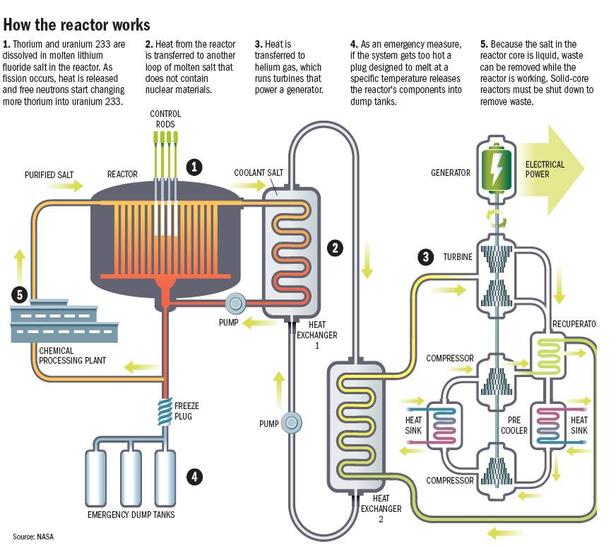
Thorium conversion: To convert the Thorium into a reactor fuel, it must be exposed to a neutron source. After absorbing a neutron from the reactor core, the Thorium is removed to a decay tank where it converts to Uranium 233, the primary fuel for the reactor. Due to the withdrawal of funding, the thorium blanket (shown in green) was never added to the MSR.
What if there is a melt down? You can't have a meltdown in a molten salt reactor, the core is already molten. In a standard reactor, a meltdown is a potential disaster. In a fluid fueled reactor, its normal operating procedure. What if there's a leak? All the salts are solid at room temperature. If any salt leaks out, it will solidify.
What if there is an explosion? There is no internal pressure in the LFTR. In fact, there is a slight negative pressure. If anything were to break open the reactor, the salts would simply solidify.
What if the reactor overheats? If the fuel salt overheats, the salt expands, which makes the reaction slow down and eventually stop. If the temperature of the salt rises too high, a solid plug of salt in a drain pipe would melt and the fuel would drain to a dump tank where a nuclear reaction is not possible. This 'freeze plug' can also be used to simply switch the reactor off.
What about proliferation of nuclear weapons? A LFTR is a very poor option for making nuclear weapons. No weapon has ever been made from U233, the LFTR's main fuel. In fact, it could burn up old weapons along with waste from solid fuel reactors.
"Advantages of thorium/uranium fuel cycle compared to the uranium/plutonium cycle have mobilized a community of scientists and engineers who have resurrected the research of the Alvin Weinberg era and are attempting to get thorium based power into the mainstream of research, policy and ultimately, production.
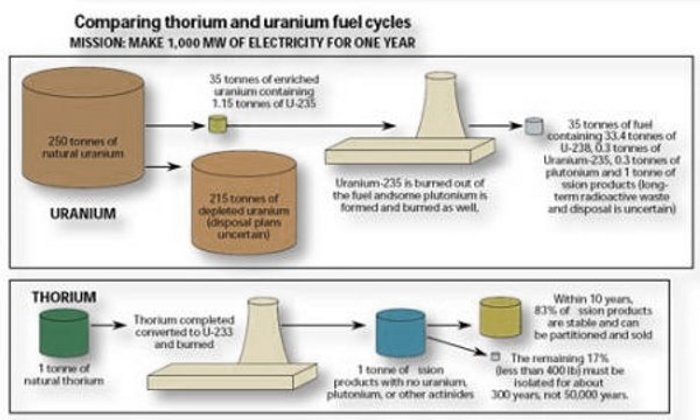
Article by Sorensen: thorium machine design is no longer active.
Nuclear engineers can extract 100% of thorium’s usable energy, compared to just 0.7% for uranium. So, as this illustration demonstrates, it takes much more raw material and leaves much more dangerous waste to generate 1,000 MW of electricity in a year using uranium than it does using thorium. Article by Sorensen: thorium machine design is no longer active.
Thorium Schedule & Benefits --- A Thorium LFTR could be working in 5 years…
TEA: thorium info 2012
Thorium activity in world: There is a lot of international interest in building a thorium power plant that would replace the uranium one.
Lawrence Livermore national laboratories are currently in the process of designing a self-contained (3 meters by 15 meters) thorium reactor. Called SSTAR (Small, Sealed, Transportable, Autonomous Reactor), this next-generation reactor will produce 10 to 100 megawatts electric and can be safely transported via ship or truck. The first units are expected to arrive in 2015, be tamper resistant, passively failsafe and have a operative life of 30+ years. SSTAR portable nuke reactor
Germany built the THTR-300 Thorium High Temperature Reactor in 1983 but stopped using it after the Chernobyl accident.
China: a major R&D program into thorium molten salt reactors is underway, with the first test reactors to be completed in 2015 and a larger-scale demo ready by the end of the decade. Thorium Energy Report China 2015
India: India has build both fission and fusion nuclear power plants.
India's thorium AHWR design reactor India: World's first thorium plant 2014 is equipped with passive shutdown systems, core heat removal through natural circulation, emergency core coolant system (ECCS) and gravity-driven water pool (GDWP), a large tank of borated water on top of the primary containment of vessel. It can operate for 120 days without operator - that’s 4 months without anyone controlling it. The design life of this reactor will last some 100 years.
The plan has a 300MW prototype and has been operating since 2016. India is now in the process of building bigger horium power plants. By 2050, thorium should meet 30% of India’s electricity demand. The AHWR is a unit that will be fueled by a mix of uranium-233 and plutonium - which will be converted from thorium by previously deployed and domestically designed fast breeder reactors. India: World's first thorium plant 2014
The completion of the AHWR design is an important step towards reducing the import of fossil fuels and combat climate change.
India will also build its own ITER Fusion Reactor. Worrall: India builds fusion reactor 2015
Other countries: Europe, Canada, Russia
There are significant forces which stand to loose big if LFTR [ thorium reactor ] becomes a commercial reality. GE makes significant money on nuclear fuel rod manufacture and handling. The coal lobby is huge in this country and hauling coal is one of the most lucrative jobs for the railroads. Factor in big oil too. Fossil fuel corporations aren't worried about fusion becoming reality any time soon hence plenty government funding for that big corps. LFTR, on the other hand, is a real competitor!
Safety of nuclear power plants
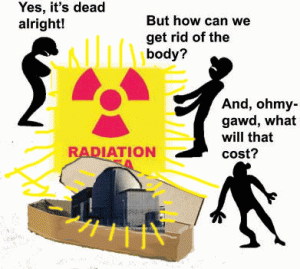 "There are more than 400 nuclear reactors operating in
the world. A nuclear power station has 35-40 years of operating life. After that it must be dismantled and the area must be cleaned up [ the decommissioning process ]. Clean-up means getting rid of used up uranium rods and other radioactive materials! But so far,
only a few nuclear power stations have been completely decommissioned in the world.
Germany has stopped building nuclear power plants, while California has stopped
using San Onufre power plant on the west coast. It has been estimated that decommissioning could last about 50 years and it would cost more than the construction cost." MacPherson: decommissioning nuclear reactors 2011
"There are more than 400 nuclear reactors operating in
the world. A nuclear power station has 35-40 years of operating life. After that it must be dismantled and the area must be cleaned up [ the decommissioning process ]. Clean-up means getting rid of used up uranium rods and other radioactive materials! But so far,
only a few nuclear power stations have been completely decommissioned in the world.
Germany has stopped building nuclear power plants, while California has stopped
using San Onufre power plant on the west coast. It has been estimated that decommissioning could last about 50 years and it would cost more than the construction cost." MacPherson: decommissioning nuclear reactors 2011
The other big "no speak" issue is storing nuclear wastes from current operating nuclear power plants. Uranium wastes have a very long half-life; like 160,000 years. At this time, most nuclear plants store waste materials on site. When there is a nuclear disaster, as occurred in Three Mile Island, Chernobyl and Fukushima, the highly radio-active and toxic waste materials are at extreme risk of being released into the environment and poison-radiate people.
The world has not found a safe place, nor a way to store toxic radioactive materials. Inability to solve this catrostrophic problem makes use of uranium in today's nuclear power plants a colossal mistake!
Al Gore has commented on the historical record and reliability of nuclear power in the United States:
"Of the 253 nuclear power reactors originally ordered in the United States from 1953 to 2008, 48 percent were canceled, 11 percent were prematurely shut down, 14 percent experienced at least a one-year-or-more outage, and 27 percent are operating without having a year-plus outage. Thus, only about one fourth of those ordered, or about half of those completed, are still operating and have proved relatively reliable." Wiki: Nuclear power USA 2011
Amory Lovins, USA physicist, commented on the historical record of nuclear power in the United States:
"Of all 132 U.S. nuclear plants built (52% of the 253 originally ordered), 21% were permanently and prematurely closed due to reliability or cost problems, while another 27% have completely failed for at least a year or more. The surviving U.S. nuclear plants produce ~90% of their full-time full-load potential, but even they are not fully dependable. Even reliably operating nuclear plants must shut down, on average, for 39 days every 17 months for refueling and maintenance, and unexpected failures do occur too." Wiki: Nuclear power USA 2011
Summary:
"The safety and efficiency of nuclear power is hotly disputed; and both advocates and opponents have at times tended to overstate their case. What cannot be disputed is that all forms of power generation are inherently dangerous [ especially coal ]; all technologies are particularly accident prone and carry huge financial risks during the pioneer stage of their development." Chater: history nuclear power Ever wonder why insurance carriers refuse to insure nuclear [ uranium ] power stations? Instead the national governments are taking the risks!
Nuclear power plants are not as reliable or safe as they are espoused by power companies. The use of uranium to generate electric energy has major hazardous flaws. The numerous nuclear power plant disasters, and especially the latest Fukushima disaster, support this observation. Inability to get rid of nuclear radiation emitting wastes in a safe manner is a colossal and ignored issue! MacPherson: decommissioning nuclear reactors 2011 Continuing concern about the lurking danger of existing use of uranium power plants has encouraged scientists to consider thorium as alternative source of electric energy power.
Reference:
Beissmann Tim, "The thorium-powered car: Eight grams, one million miles," Car Advice, August 16, 2011. Beissmann: thorium driven car 2011
Chater James, "A history of nuclear power," Focus on Nuclear Power Generation, 2005. Chater: history nuclear power
Clark Duncan, "Thorium nuclear power," The Manchester Guardian. July 12, 2009. Clark: Thorium nuclear power
Fan-Chiang Liona, "Fusion Basic Economics," 21st CENTURY SCIENCE & TECHNOLOGY, August 2014. Fan-Chiang: Fusion economics 2014
Fissile: Unlike natural uranium, natural thorium contains only trace amounts of fissile material (such as 231 Th), which are insufficient to initiate a nuclear chain reaction. Fissile means it cannot go "critical" and generate a nuclear chain reaction. Thorium fuel cycle
Ghunawat Virendrasingh, "Design of world's first Thorium based nuclear reactor is ready," IndiaToday, Mumbai, February 14, 2014. Ghunawat: world's first thorium plant
Hargraves Robert and Ralph Moir, "Liquid Fluoride Thorium Reactors - An old idea in nuclear power gets reexamined," American Scientist Reprint, July-August, 2010. Article by Hargraves: Thorium reactors pdf is no longer active.
India developing thorium reactor: "Thorium: Green Friendly Nuclear Power." March 06, 2011. Original article taken off the internet.
Department of Atomic Energy India has unveiled the design of two reactors AHWR and AHWR-LEU, both in the mid size (300 MWE) range. Currently India’s Kakrapar-1 reactor is the world’s first reactor which uses thorium rather than depleted uranium. India is also developing a 300 MW thorium-based Advanced Heavy Water Reactor (AHWR), which should be fully operational in 2015.
The AHWR is mainly a thorium-fueled reactor meant for internal use, not for export. It represents a stage 3 reactor i.e. it uses as input the U 233 output produced from Th 232 (stage 2 fast breeders) and should be situated in relative geographic proximity of the Stage 2 Fast Breeders. It has been designed, developed, validated and currently in production with a target of 2012.
The basic design of the AHWR-LEU was revealed domestically in 2008 and to the international community at Vienna in Sept 2009. It runs on a unique 20:80 fuel mix that combines the features of all three stages i.e. low enriched Uranium (stage 1), in-situ conversion of Th to U (it breeds U 233 from Th, a stage 2 process. Howver, because this is a once-through process, some have labeled it a “passive breeder” reactor) and also uses the Th converted U as fuel (stage 3). The AHWR-LEU promises a host of safety, waste management and anti-proliferation features, a design life of 100 years with “plug and play” convenience. This is the reactor meant for export and it is said to be in “development and validation” phase at the BARC with a hard stop of 2020 for achieving complete commercial viability.
The information about India developing more power plants using thorium has changed since the new government came into power in 2018.
LeBlanca David, "Molten salt reactors: A new beginning for an old idea," Elsevier Nuclear Engineering and Design 240 (2010) 1644–1656 Article by LeBlanca: Molten salt reactors is no longer active.
List of thorium-fueled reactors [ From IAEA TECDOC-1450 "Thorium Fuel Cycle - Potential Benefits and Challenges", Table 1: Thorium utilization in different experimental and power reactors. ] Wiki: Thorium fuel cycle
| Name | Country | Type | Power | Fuel | Operation period |
| AVR | Germany | HTGR, Experimental (Pebble bed reactor) | 15 MW(e) | Th+235 U Driver Fuel, Coated fuel particles, Oxide & dicarbides |
1967–1988 |
| THTR-300 | Germany | HTGR, Power (Pebble Type) | 300 MW(e) | Th+235 U, Driver Fuel, Coated fuel particles, Oxide & dicarbides |
1985–1989 |
| Lingen | Germany | BWR Irradiation-testing | 60 MW(e) | Test Fuel (Th,Pu)O2 pellets | 1968-1973 |
| Dragon (OECD-Euratom) | UK (also Sweden, Norway & Switzerland) | HTGR, Experimental (Pin-in-Block Design) | 20 MWt | Th+235 U Driver Fuel, Coated fuel particles, Oxide & Dicarbides |
1966–1973 |
| Peach Bottom | USA | HTGR, Experimental (Prismatic Block) | 40 MW(e) | Th+235 U Driver Fuel, Coated fuel particles, Oxide & dicarbides |
1966–1972 |
| Fort St Vrain | USA | HTGR, Power (Prismatic Block) | 330 MW(e) | Th+235 U Driver Fuel, Coated fuel particles, Dicarbide |
1976–1989 |
| MSRE ORNL | USA | MSBR | 7.5 MWt |
233 U Molten Fluorides |
1964–1969 |
| BORAX-IV & Elk River Station | USA | BWR (Pin Assemblies) | 2.4 MW(e); 24 MW(e) | Th+235U Driver Fuel Oxide Pellets | 1963 - 1968 |
| Shippingport | USA | LWBR PWR, (Pin Assemblies) | 100 MW(e) | Th+233 U Driver Fuel, Oxide Pellets |
1977–1982 |
| Indian Point 1 | USA | LWBR PWR, (Pin Assemblies) | 285 MW(e) | Th+233 U Driver Fuel, Oxide Pellets |
1962–1980 |
| SUSPOP/KSTR KEMA | Netherlands | Aqueous Homogenous Suspension (Pin Assemblies) | 1 MWt | Th+HEU, Oxide Pellets | 1974–1977 |
| NRX & NRU | Canada | MTR (Pin Assemblies) | 20MW; 200MW (see) | Th+235 U, Test Fuel |
1947 (NRX) + 1957 (NRU); Irradiation–testing of few fuel elements |
| CIRUS; DHRUVA; & KAMINI | India | MTR Thermal | 40 MWt; 100 MWt; 30 kWt (low power, research) | Al+233 U Driver Fuel, ‘J’ rod of Th & ThO2, ‘J’ rod of ThO2 |
1960-2010 (CIRUS); others in operation |
| KAPS 1 &2; KGS 1 & 2; RAPS 2, 3 & 4 | India | PHWR, (Pin Assemblies) | 220 MW(e) | ThO2 Pellets (For neutron flux flattening of initial core after start-up) | 1980 (RAPS 2) +; continuing in all new PHWRs |
| FBTR | India | LMFBR, (Pin Assemblies) | 40 MWt | ThO2 blanket | 1985; in operation |
MacPherson Christina, "The eternal cost of dealing with dead, but radioactive, nuclear reactors," Nuclear News, September 15, 2011. MacPherson: decommissioning nuclear reactors 2011
"There are more than 400 nuclear reactors operating in various countries. A nuclear power station has 35-40 years of operating life. After that it must be dismantled and the area must be cleaned up (the decommissioning process). But so far, no nuclear power station has been completely decommissioned in the world. It has been estimated that decommissioning could last about 50 years and it would cost more than the construction cost."
Pentland William, "Is Thorium the Biggest Energy Breakthrough Since Fire? Possibly," Forbes, September 11, 2011. Pentland: Thorium energy breakthru' 2011
Sazawal Vijay, "India Slashes Plans for New Nuclear Reactors by Two-Thirds," Neutron Bits, April 6, 2018. Sazawal: India cuts back on power 2018
Sorensen Kirk, "Thinking Nuclear? Think Thorium," [ Thorium, a Readily Available and Slightly Radioactive Mineral, Could Provide the World with Safer, Clean Energy ] Machine Design, March 16, 2010. Article by Sorensen: thorium machine design is no longer active.
Sorensen Kirk, "Thorium," Ted U-tube, April 22, 2011. Sorensen: thorium Ted Utube
Kirk Sorensen is founder of Flibe Energy and is an advocate for nuclear energy based on thorium and liquid-fluoride fuels. For five years he has authored the blog "Energy from Thorium" and helped grow an online community of thousands who support a renewed effort to develop thorium as an energy source. He is a 1999 graduate of Georgia Tech in aerospace engineering and is also a graduate student in nuclear engineering at the University of Tennessee. He has spoken publicly on thorium at the Manchester International Forum in 2009, at NASA's Green Energy Forum in 2008, and in several TechTalks at Google. He has been featured in Wired magazine, Machine Design magazine, the Economist, the UK Guardian and Telegraph newspapers, and on Russia Today. He also taught nuclear engineering at Tennessee Technological University as a guest lecturer. He is active in nonprofit advocacy organizations such as the Thorium Energy Alliance and the International Thorium Energy Organization. He is married and has four small children.
SSTAR, "Small, sealed, transportable, autonomous reactor," Wikipedia. SSTAR portable nuke reactor
Thorium Energy Alliance [ John Kutsch director ], "T.E.A. Resources," TEA: thorium info 2012
Thorium engine power plant cost: Article about Thorium engine power plant cost is no longer active.
| Item | $ Cost | $ per month, 40 years, 8% financing, levelized | $ per KWH @ 90% | |
|---|---|---|---|---|
|
Construction |
200,000,000 |
1,390,600 |
0.0214 |
|
|
Start-up U/Pu100 kg |
1,000,000 |
6,953 |
0.000108 |
|
|
Thorium fuel |
10,700/yr |
892 |
0.00000138 |
|
|
Decomm @ ½ const |
100,000,000 |
960 |
0.00000148 |
|
|
Operations |
1,000,000/yr |
83,333 |
0.00128 |
|
|
TOTAL |
0.0228 |
|||
Worrall Eric, "India: We will build our own ITER Fusion Reactor," The Times of India, April 10, 2015. Worrall: India builds fusion reactor 2015
Westenhaus Brian, "One Step Closer to a Thorium Fueled Power Plant," New Energy and Fuel, May 3, 2010. Westenhaus: Norway-Sweden activity 2010
Wikipedia, "Molten Salt Reactor." Wiki: MSR
Wikipedia, "Nuclear power in the United States," 2011. Wiki: Nuclear power USA 2011
Wikipedia, Thorium. Wiki: Thorium
World Nuclear Association, "Outline History of Nuclear Energy," June 2010. World Nuclear Assoc: history
Worthington Bryone, "Post-Fukushima world must embrace thorium, not ditch nuclear," The Manchester Guardian Uk, March 09, 2012. Worthington: thorium activity internationally 2012 The man whose inventions led to nuclear power proliferation knew thorium was preferable to uranium – it's time we caught up.
